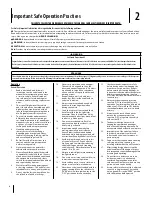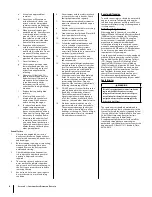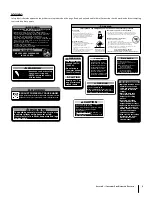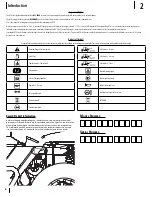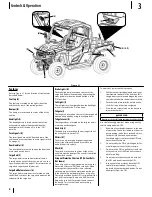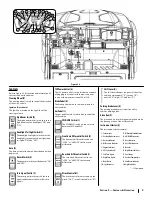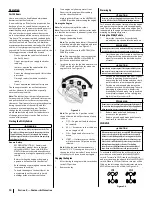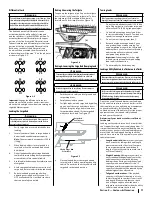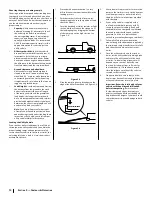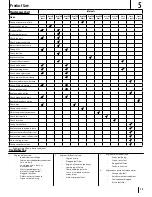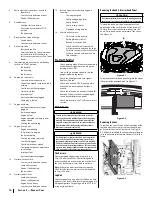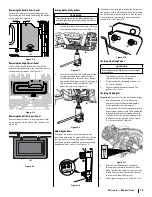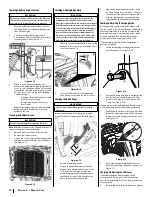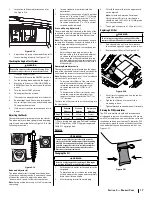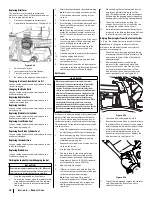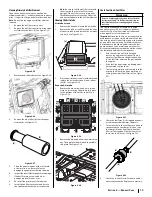
4
S
ection
2 — i
mportant
S
afe
o
peration
p
racticeS
a.
Use only an approved fuel
container.
b.
Never carry or fill containers
inside the vehicle’s bed or on
a truck or trailer. Always place
containers on the ground away
from your vehicle before filling.
c.
When practical, remove gas-
powered vehicle from the truck
or trailer and refuel it on the
ground. If this is not possible,
then refuel on a trailer with a
portable container, rather than
from a fuel dispenser nozzle.
d.
Keep the nozzle in contact
with the rim of the fuel tank or
container opening at all times
until fueling is complete. Do not
use a nozzle lock-open device.
e.
Extinguish all cigarettes, cigars,
pipes and other sources of ignition.
f.
Never fuel indoors.
g.
Never remove gas cap or add
fuel while the engine is hot or
running. Allow engine to cool
at least two minutes before
refueling.
h.
Never over fill fuel tank. Fill
tank to no more than one inch
below bottom of filler neck to
allow space for fuel expansion.
Leave additional room for
fuel expansion if the utility
vehicle will be in a high-altitude
situation.
i.
Replace fuel cap and tighten
securely.
j.
If fuel is spilled, wipe it off
immediately. Move vehicle to
another area. Wait 5 minutes
before starting the engine.
k.
To reduce fire hazards, keep
engine compartment and
exhaust system free of grass,
leaves, or other debris build-up.
Clean up oil or fuel spillage and
remove any fuel soaked debris.
l.
Never store the vehicle or fuel
container inside where there
is an open flame, spark or pilot
light as on a water heater, space
heater, furnace, clothes dryer or
other gas appliances.
General Service
1.
Never run an engine indoors or in a
poorly ventilated area. Engine exhaust
contains carbon monoxide, an odorless,
and deadly gas.
2.
Before cleaning, repairing, or inspecting,
make certain all moving parts have
stopped. Remove the key to prevent
unintended starting.
3.
Check brake operation frequently as
it is subjected to wear during normal
operation. Adjust and service as
required.
4.
The cooling system is under pressure,
never remove the radiator cap when
the system is hot. Slowly turn the cap to
the first stop to release pressure before
removing the cap.
5.
Keep all nuts, bolts, and screws tight to
be sure the vehicle is in safe working
condition.
6.
Never tamper with the safety interlock
system or other safety devices. Check
their proper operation regularly.
7.
Never attempt to make adjustments or
repairs to the vehicle while the engine
is running.
8.
Wait for vehicle to cool before servicing
exhaust or coolant system.
9.
Stop vehicle on level ground. Place shift
lever in park before servicing.
10.
Maintain or replace safety and
instruction labels, as necessary.
11.
Follow the vehicle maintenance and
service schedules to ensure that
all mechanical and safety systems
are working properly and not worn
excessively. Failure to do so can result in
accidents, injuries or death.
12.
Observe proper disposal laws and
regulations for gas, oil, etc. to protect
the environment.
13.
Prior to disposal, determine the proper
method to dispose of waste from your
local Environmental Protection Agency.
Recycling centers are established to
properly dispose of materials in an
environmentally safe fashion.
14.
Use proper containers when draining
fluids. Do not use food or beverage
containers that may mislead someone
into drinking from them. Properly
dispose of the containers immediately
following the draining of fluids.
15.
DO NOT pour oil or other fluids into the
ground, down a drain or into a stream,
pond, lake or other body of water.
Observe Environmental Protection
Agency regulations when disposing
of oil, fuel, coolant, brake fluid, filters,
batteries, tires and other harmful waste.
16.
We do not recommend the use of a
pressure washer to clean your vehicle.
They may cause damage to electrical
components; wheel spindles; pulleys;
bearings; or the engine. The use of high-
pressure water will result in shortened
life and reduce serviceability.
Do not modify engine
To avoid serious injury or death, do not modify
engine in any way. Tampering with engine
can lead it to operate at unsafe speeds. Never
tamper with factory setting of the engine and
its components.
Notice Regarding Emissions
Where applicable, this vehicle is certified to
federal EPA and California Air Resources Board
(CARB) emissions standards for Off-Highway
Recreational Vehicles (OHRV). The engine
owner’s manual is supplied by the engine
manufacturer, and provides additional
information relating to the emission system,
warranty, and maintenance of the engine in
accordance with EPA and/or CARB regulations.
Consult your engine manual for the fuel
requirements for your engine.
Gasoline powered products may be equipped
with the following emission control systems:
Engine Modification (EM), Oxidizing Catalyst
(OC), Oxygen Sensor (O2S), Multi-port Fuel
Injection (MFI), Electronic Control Module
(ECM), Secondary Air Injection (SAI) and Three
Way Catalyst (TWC). When required, models
are equipped with low permeation fuel lines
and fuel tanks for evaporative emission
control. Please contact Customer Support
for information regarding the evaporative
emission control configuration for your model.
Spark Arrestor
WARNING
This vehicle is equipped with an internal combustion
engine and should not be used on or near any
unimproved forest-covered, brush-covered or grass-
covered land unless the engine’s exhaust system is
equipped with a spark arrestor meeting applicable
local or state laws (if any).
The spark arrestor should be maintained in
effective working order by the operator. In the
State of California the above is required by law
(Section 4442 of the California Public Resources
Code). Other states may have similar laws.
Federal laws apply on federal lands.
A replacement spark arrestor for the muffler
is available through your nearest engine
authorized service dealer or contact the service
department, P.O. Box 361131 Cleveland, Ohio
44136-0019.


